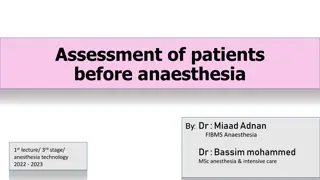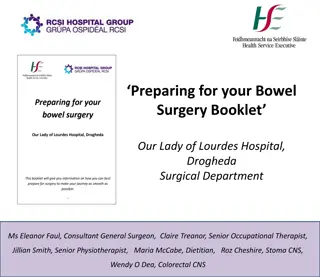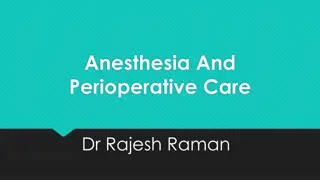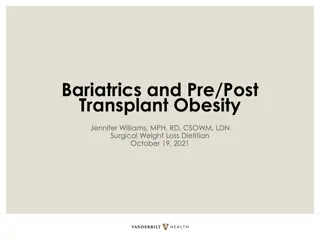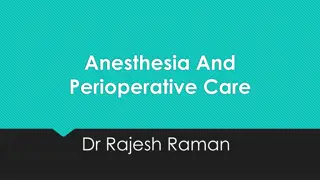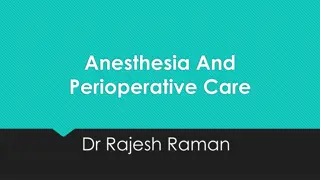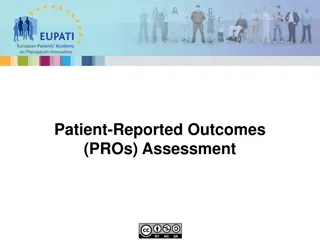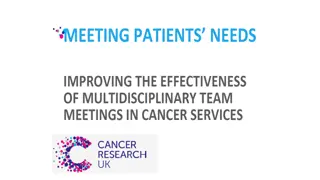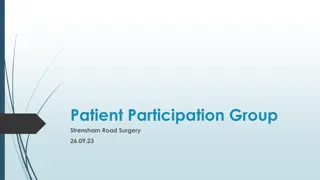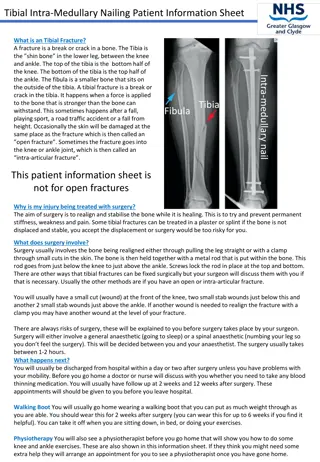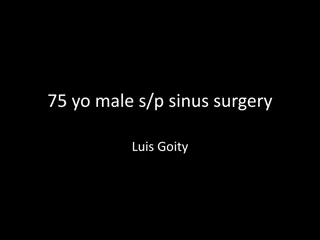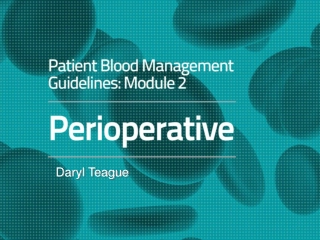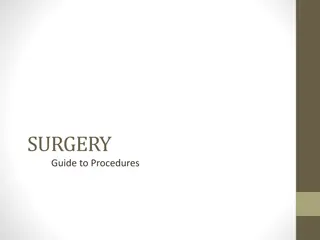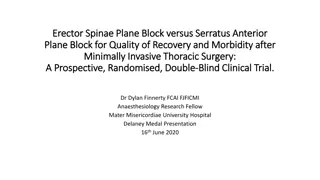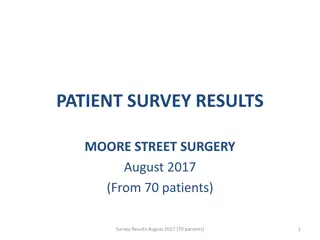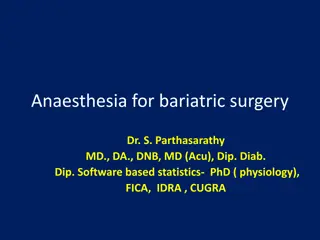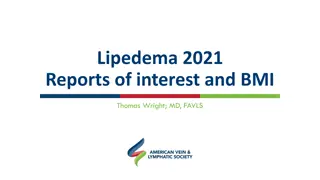Preoperative Planning for Surgery: Optimizing Patient Outcomes
Major surgery can induce physiological changes, increasing oxygen demand and leading to postoperative risks. Careful preoperative planning is crucial to minimize adverse effects. This involves thorough history-taking, examination, and investigations to assess patient readiness and optimize their condition. Risks of surgery, anesthesia, comorbid conditions, and postoperative care should be discussed to ensure informed decision-making. Screening for fitness, past medical history, and examination specific to surgery are essential steps in planning for successful outcomes.
Download Presentation

Please find below an Image/Link to download the presentation.
The content on the website is provided AS IS for your information and personal use only. It may not be sold, licensed, or shared on other websites without obtaining consent from the author. Download presentation by click this link. If you encounter any issues during the download, it is possible that the publisher has removed the file from their server.
E N D
Presentation Transcript
By dr. firas majeed Assistant professor/General surgery Consultant surgeon
The stress of major surgery can lead to increased oxygen demand by about 40%. Changes such as cytokine release- related inflammatory changes, endocrine responses, hypercoagulability and redistribution of fluid between compartments may last several postoperative days. The purpose of careful preoperative planning is to minimize the unwanted effects of these physiological changes. Systematic history taking, examination and ordering of investigations at the preoperative clinic should include not only an assessment of functional reserve but also the formulation of advice on optimization, to best cope with the anticipated operative stress
Risks of surgery, anesthesia and the effects of comorbid conditions should be discussed so that the patient can make an informed decision. Patients should be given advice on nil by mouth (NBM) and regular medication and premedication at the preoperative visit. Preoperative plan for the best patient outcomes Gather and record all relevant information Optimize patient condition Choose surgery that offers minimal risk and maximum benefit Anticipate and plan for adverse events Adequate hydration, nutrition and exercise are advised
History taking Screening questions will reveal fitness for surgery and anesthesia. Patients with recent chest infections should be assessed for anesthetic risks and postoperative surgical infection. Inability to achieve four metabolic equivalents, e.g. climbing a flight of stairs, increases cardiac risk after major surgery. The history of past surgery and anesthesia can reveal the problems one may face during current hospitalization (e.g. intra-abdominal adhesions for planned laparoscopic surgery, suxamethonium apnea). The use drugs and alcohol consumption should be noted as they are known to be associated with adverse outcomes. Check for allergies and risk factors for deep vein thrombosis (DVT). Social history, ability to communicate and mobility are important in planning rehabilitation after surgery. Such as anemia, angina, palpitations or obesity.
Examination specific to surgery At preoperative assessment, the clinical findings, site, side, specific imaging or investigation findings related to the pathology for which the surgery is proposed should be noted. Suitability of the patient for the proposed surgical option and vice versa should also be assessed. For example, laparoscopic procedures are less invasive and are therefore preferred inmost; however, not all patients can tolerate pneumoperitoneum and positioning. The type of surgery along with patient comorbidities determine perioperative risks, for example perioperative mortality in major surgery such as that of open aortic aneurysm repair in the UK is 3% and that with endovascular repair is 1%. Sources of potential bacteraemia can compromise surgical results especially if artificial material is implanted, such as in joint replacement surgery or arterial grafting. Check for and treat infections in the preoperative period, e.g. infected toes, pressure sores, teeth and urine; screen the patients for methicillin-resistant Staphylococcus aureus colonisation.
Full blood count. A full blood count (FBC) is needed for major operations, in the elderly and in those with anaemia or pathology with ongoing blood loss and chronic disease. In case of suspicion or history of sickle crisis, a sickle cell test is needed in patients of Afro-Caribbean and Indian subcontinent origin. Urea and electrolytes. Urea and electrolytes (U&Es) are needed before all major operations, in most patients over 65 years of age especially with cardiovascular, renal and endocrine disease, or if significant blood loss is anticipated. It is also needed in those on medications that affect electrolyte levels, e.g. steroids, diuretics, digoxin, non-steroidal anti-inflammatory drugs, intravenous fluid or nutrition therapy and endocrine problems. Electrocardiography. Electrocardiography (ECG) is required for those patients over 65 years of age and symptomatic patients with a history of rheumatic fever, diabetes, cardiovascular, renal and cerebrovascular disease, with and without severe respiratory problems. It will also depend on if the surgery is minor/intermediate or major.
Chest radiograph. Cost-effectiveness and risks of radiation exposure mean that chest radiographs should be restricted to specific patients, such as those with cardiac failure, severe chronic obstructive pulmonary disease (COPD),acute respiratory symptoms, pulmonary cancer, metastasis or effusions or those who are deemed to be at risk of active pulmonary tuberculosis. Clotting screen. If a patient has a history suggestive of a bleeding diathesis, liver disease, eclampsia, cholestasis or has a family history of bleeding disorder, or is on antithrombotic or anticoagulant agents then coagulation screening will be needed. Urinalysis. Dipstick testing of urine should be performed on all patients to detect urinary infection, biliuria, glycosuria and inappropriate osmolality. -Human chorionic gonadotrophin. Women of child-bearing age should be asked sensitively about their pregnancy status. If in doubt a laboratory test or a reliable pregnancy kit (low cost) can be used, after obtaining consent from the patient, to avoid danger of exposure to surgery and anaesthesia on the fetus.
Blood glucose and HbA1c. Poor control of diabetes can lead to perioperative infection and slow recovery in patients with diabetes mellitus and endocrine problems. HbA1C indicates how well diabetes has been controlled over a longer duration. Early mobilisation, oral intake and return to routine medication should be the goals in management of diabetes. Arterial blood gases. A low-cost tool that can give quick and vital information in acute or chronic severe respiratory conditions, acid base disturbances. Liver function tests. These are indicated in patients with jaundice, known or suspected hepatitis, cirrhosis, malignancy or in patients with poor nutritional status. Other investigations. Specialist radiological views and recent imaging are sometimes required. If imaging is going to be needed during surgery, then this needs to be planned in advance.
Cardiovascular disease In patients with ischaemic heart disease the cardiac and coronary reserve can be evaluated using a stress test (stress ECG, stress echocardiogram, myocardial scintigraphy). The tests have a high negative predictive value but a relatively low positive predictive value. If the test is negative, the patient is unlikely to have IHD; conversely, if it is positive the chances of the patient actually having IHD is not necessarily very high, but there is a need for further investigation such as coronary angiography. In patients with any suggestion of valvular heart disease or poor left ventricular function, an echocardiogram should be obtained. Pressure gradients across the valves, dimensions of the chambers and contractility can be determined using echocardiography; an ejection fraction of less than 30% is associated with poor patient outcomes. Cardiopulmonary exercise testing provides a non-invasive assessment of combined pulmonary, cardiac and circulatory function. .
The patient should be referred to a cardiologist if: A murmur is heard and the patient is symptomatic. The patient is known to have poor left ventricular function or cardiomegaly. Ischaemic changes can be seen on ECG even if the patient is not symptomatic (silent ischaemia, silent MI s are frequent). There is an abnormal rhythm on the ECG, for example tachy- /bradycardia or heart block
Prior to elective surgery blood pressure should be controlled to near 160/100 mmHg. If a new antihypertensive agent is introduced, a stabilisation period of at least 2 weeks should be allowed. Patients with angina, that is not well controlled, should be investigated further by a cardiologist. Pharmacological protection is indicated. Patients on -blockers and on statins should be maintained on their medication. Most long-term cardiac medications should be continued over the perioperative period. Angiotensin-converting enzyme (ACE) inhibitors and receptor blockers are often omitted 24 hours prior to surgery and reintroduced gradually in the postoperative period. After a proven myocardial infarction , elective surgery should be postponed for 3 6 months to reduce the risk of perioperative reinfarction.
As primary percutaneous intervention is the treatment of choice for acute coronary syndromes, many patients receive stents and are on dual antiplatelet therapy for 12 months. If surgery is absolutely necessary within the period of dual antiplatelet therapy, the management strategy should be decided jointly by surgeon, cardiologist, anaesthetist and patient, as it is essential to consider the balance of risk of continuing antiplatelet agents (with the risk of increased bleeding) and stopping them with the risk of stent thrombosis). The risk of stent thrombosis with consequences of MI and death is reduced if elective surgery is delayed until after dual antiplatelet therapy is no longer needed (about 6 weeks after bare metal and 12 months after drug- eluting stent insertion, although with the newest drug-eluting stents 6 months dual antiplatelet therapy may be enough) If surgery cannot be postponed and the risk of significant perioperative bleeding is low, dual antiplatelet therapy can be continued during surgery. If the benefits of surgery can be negated by bleeding in closed cavities (spinal, intracranial, cardiac, posterior chamber surgery)clopidogrel or ticagrelor therapy may have to be stopped and, if possible, aspirin continued. However, a cardiology opinion should be sought. of the eye and prostate
Dysrhythmias In patients with atrial fibrillation, -blockers, digoxin or calcium channel blockers should be started preoperatively (or continued if the patient is already on such medication) in order to control rate and possibly rhythm. Cardiac output can increase by 15% if sinus rhythm is restored. Warfarin in patients with atrial fibrillation (AF) should be stopped 5 days preoperatively to achieve an international normalised ratio (INR) of 1.5 or less, which is safe for most surgery. Bridging therapy with unfractionated heparin or low molecular weight heparin (LMWH) is recommended for patients with AF and a mechanical heart valve undergoing procedures that require interruption of warfarin. Decisions on bridging therapy should balance the risks of stroke and bleeding.
Implanted pacemakers and cardiac defibrillators Monopolar diathermy activity during surgery may be sensed by the pacemaker as ventricular fibrillation. Therefore, cardioversion and overpace modes must be turned off (and switched on after surgery) or converted to ventricle paced, not sensed with no response to sensing (VOO) mode. Bipolar diathermy should be made available at surgery. Valvular heart disease While anaesthetic management is altered to achieve haemodynamic stability in moderate valvular diseases, the patients with severe aortic and mitral stenosis may benefit from valvuloplasty before elective non-cardiac surgery. Appropriate referral to anaesthetist and cardiologist should be made. In patients with mechanical heart valves, warfarin needs to be stopped for 5 days before surgery, and an infusion of unfractionated heparin started when the INR falls below 1.5. The activated partial thromboplastin time (APTT), should be monitored to keep it at 1.5 times normal and the infusion is then stopped 2 hours before surgery.
Anaemia and blood transfusion Patients found to be anaemic at preoperative assessment should be investigated for the cause of their anaemia. They should be treated with iron and vitamin supplements Chronic anaemia is well tolerated in the perioperative period; however, if the patient is undergoing a major procedure preoperative transfusion may be considered. If excessive bleeding is expected, then a preoperative group and save should be performed and an appropriate number of units of blood cross matched. Respiratory disease Postoperative respiratory complications, such as pneumonia, are a major cause of morbidity and mortality especially after major abdominal and thoracic surgery. A preoperative chest radiograph or scan is useful in a patient with known emphysematous bullae, pulmonary cancer, metastasis or effusions. Patients on oral steroid treatment, oxygen therapy or who have a forced expiratory volume in the first second (FEV1) less than 30% of predicted value (for age, weight and height), or PaCO2 level of greater than 6kPa, have severe disease and are at risk of pneumonia and respiratory failure in the postoperative period.
Patients should continue to use their regular inhalers until the start of anaesthesia. Brittle asthmatics may also need extra steroid cover. Encourage the patients to be compliant with the medications, take a balanced diet and stop smoking. Regional anaesthetic techniques and less invasive surgical options should be considered in severe cases. Elective surgery should be postponed until acute exacerbations are treated.. The patient should be referred to a respiratory physician if: There is a severe disease or significant deterioration. Major surgery is planned in a patient with significant respiratory comorbidities. Right heart failure is present dyspnoea, fatigue, tricuspid regurgitation, hepatomegaly and oedematous feet. The patient is young and has severe respiratory problems (indicates a rare condition).
Gastrointestinal disease Nil by mouth and regular medications Patients are advised not to take solids within 6 hours and clear fluids within 2 hours before anaesthesia to avoid the risk of acid aspiration syndrome. If the surgery is delayed, oral intake of clear fluids should be allowed until 2 hours before surgery or intravenous fluids should be started, especially in vulnerable groups of patients e.g. children, the elderly and diabetics. Patients can continue to take their specified routine medications with sips of water in the NBM period. Regurgitation risk Patients with hiatus hernia, obesity, pregnancy and diabetes are at high risk of pulmonary aspiration, even if they have been NBM before elective surgery. Clear antacids, H2-receptor blockers, e.g. ranitidine, or proton pump inhibitors, e.g.omeprazole, may be given at an appropriate time in the preoperative period.
Liver disease the cause of the disease needs to be known,. As it influence the choice and outcome of anaesthesia and surgery Elective surgery should be postponed until any acute episode has settled (e.g. cholangitis). The blood tests that need to be performed include liver function tests, Genitourinary disease Renal disease Underlying conditions leading to chronic renal failure such as diabetes mellitus, hypertension and ischaemic heart disease, should be stabilised before elective surgery. Appropriate measures should be taken to treat acidosis, hypocalcaemia and hyperkalaemia of greater than 6 mmol/L. Arrangements should be made to continue peritoneal or haemodialysis untila few hours before surgery. After the final dialysis before surgery, a blood sample should be sent for FBC and U&Es. Chronic renal failure patients often suffer chronic microcytic anaemia that is well tolerated; therefore, preoperative blood transfusion is often not necessary. .
Acute kidney injury can present with emergency surgery. In these patients, medical treatment should be started Early and carried on through surgery and through into the critical care Urinary tract infection These infections should be treated before embarking on elective surgery where infection carries dire consequences, e.g. joint replacement. For emergency procedures,antibiotics should be started and care taken to ensure that the patient maintains a good urine output before, during and after surgery Endocrine and metabolic disorders Malnutrition BMI below 15 is associated with significant hospital mortality.Nutritional support for a minimum of 2 weeks before surgery is required to have any impact on subsequent morbidity. If a patient is unlikely to be able to eat for a significant period, arrangements should be made by the preoperative assessment team to start nutritional support in the immediate postoperative phase.
Obesity Morbid obesity can be defined as BMI of more than 35and is associated with increased risk of postoperative complications. There is evidence to suggest that patient outcomes improve with 1. more than 6 weeks of use of a continuous positive airway pressure (CPAP) device preoperatively, and cholesterol reducing agents in the perioperative phase. 2. If possible surgery should be delayed until the patient is more active and has lost weight. If this fails, prophylactic measures need to be taken (such as preventative measures for acid aspiration and DVT) : 3.associated risks need to be explained prior to the surgery.
Diabetes mellitus Diabetes and associated cardiovascular and renal complications should be controlled to as near normal level as possible before embarking on elective surgery For elective surgery, HBA1c of <69 mmol/mol is recommended. Lipid- lowering medication should be started in patients who are in a highrisk group for cardiovascular complications of diabetes. Patients with diabetes should be first on the operating list and, if the operation is in the morning, advised to omit the morning dose of medication and breakfast., the patient s blood sugar levels should be checked 2 hourly. For those on the afternoon list, breakfast can be given with half their regular dose of intermediate-acting insulin (or full dose oral antidiabetic Agents. An intravenous insulin sliding scale should be started for insulin- dependent diabetes mellitus patients undergoing major surgery, or if blood sugar is difficult to control for other reasons.
Adrenocortical suppression Patients receiving oral adrenocortical steroids should be asked about the dose and duration of the medication in view of supplementation with extra doses of steroids perioperatively, to avoid an Addisonian crisis Coagulation disorders Thrombophilia Patients with a strong family history or previous personal history of thrombosis should be identified .They will need thromboprophylaxis in the perioperative period. The progesterone-only contraceptive pill should be continued; Consider stopping estrogen-containing oral contraceptives or hormone replacement therapy 4 weeks before surgery Patients with a low risk of thromboembolism can be given thromboembolism- deterrent stockings to wear during the perioperative period. High-risk patients with a history of recurrent DVT, pulmonary embolism and arterial thrombosis will be on warfarin. This should be stopped before surgery and replaced by low molecular weight heparin
Neurological and psychiatric disorders These patients may be on anti-platelet agents or anticoagulants. If it is felt that the neurological and cardiovascular thrombotic risks are low, antiplatelet agents should be withdrawn (7 days for aspirin, 10 days for clopidogrel). If the thrombotic risks are perceived to be high and the patient is undergoing surgery with a high risk of bleeding, aspirin alone should be continued. Anticonvulsants and anti-Parkinson medication is continued perioperatively to help early mobilisation of the patient. Lithium should be stopped 24 hours prior to surgery; The anaesthetist should be informed if patients are on psychiatric medications such as tricyclic antidepressants or monoamine oxidase inhibitors, as these may interact with anaesthetic
Musculoskeletal disorders Rheumatoid arthritis can lead to an unstable cervical spine with the possibility of spinal cord injury during intubation. Therefore, flexion and extension lateral cervical spine radiographs should be obtained in symptomtic patient In ankylosing spondylitis patients, in addition to the problems discussed above, techniques of spinal or epidural anaesthesia are often challenging. Patients with systemic lupus erythematosus may exhibit a hypercoagulable state along with airway difficulties.
Airway assessment The ability to intubate the trachea and oxygenate the patient are basic and crucial skills of the anaesthetist. The ease or difficulty encountered when performing airway manoeuvres can be predicted by simple examination findings of full mouth opening (modified Mallampati class), jaw protrusion, neck movement and thyromental distance. The anaesthetist should look for loose teeth, obvious tumours, scars, infections, obesity, thickness of the neck, etc., which will indicate difficulty in visualising the airway. When more than one of the above tests are positive, the chances of experiencing difficulty in obtaining and securing the airway become greater. Airway assessment (Samsoon and Young modified Mallampati test).
Patient factors that predispose to high risk of morbidity and mortality.
Management f risk The patient and the surgeon may choose a less extensive or even a non- surgical option where risks of the definitive procedure are deemed to be too high or unacceptable The Royal College of Surgeons (RCS) of England has recommended that thepatients who are predicted to have greater than 5% mortality risk should have active consultant input in all stage of their management. Surgical procedures in those with predicted mortality of >10% should be conducted under the direct supervision of consultant surgeon or anaesthetist and should be managed in the critical care facility. Depending on particular comorbidities, it may be possible for a patient s underlying conditions to be improved by optimising their medical therapy. The likelihood of the high-risk patient requiring postoperative critical care should be planned preoperatively and discussed with the duty critical care physician. The identification of patients who will benefit the most from these interventions is important, not only for th improvement of outcomes but also the effective allocation of resources. As discussed above, emergency surgery is associated with higher risks because by its very nature there is less time
ARRANGING THEATRE LIST The date, place and time of operation should be matched with availability of personnel. Appropriate equipment and instruments should be made available. The operating list should be distributed as early as possible to all staff who are involved in making the list run smoothly . If this is done electronically, familiarity with the computer system is required. Priorities patients, e.g. children and diabetic patients should be placed at the beginning of the list; life- and limb-threatening surgery should take priority; cancer patients need to be treated early.



